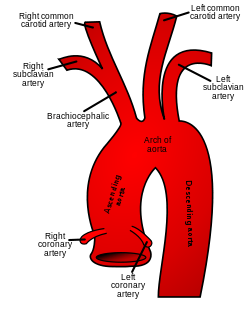Descending aorta
| Artery: Descending aorta | |
|---|---|
 | |
| Plan of the branches. | |
 | |
| The thoracic aorta, viewed from the left side. | |
| Latin | Aorta descendens, pars descendens aortae |
| Gray's | p.598 |
| Source | Aorta |
| Branches | Thoracic aorta Abdominal aorta |
| Precursor | Dorsal aorta |
| MeSH | Aorta,+Thoracic |
The descending aorta is part of the aorta, the largest artery in the body. The descending aorta is the part of the aorta beginning at the aortic arch that runs down through the chest and abdomen. The descending aorta is divided into two portions, the thoracic and abdominal, in correspondence with the two great cavities of the trunk in which it is situated. Within the abdomen, the descending aorta branches into the two common iliac arteries which serve the pelvis and eventually legs.
The ligamentum arteriosum connects the superior surface of the left branch of the pulmonary artery to the proximal descending aorta.[1] The blood bypasses the lungs through the ductus arteriosus during embryonic circulation. This becomes the ligamentum arteriosum postnatal as pulmonary circulation begins.
See also
References
- ↑ D. Cheitlin, Melvin; C. Ursell, Philip (2011). "Cardiac Anatomy". In Chatterjee, Kanu. Cardiology: An Illustrated Textbook. JP Medical Ltd. p. 6. ISBN 9789350252758.
This article incorporates text from a public domain edition of Gray's Anatomy.
External links
- SUNY Figs 19:04-03 - "Left side of the mediastinum."
| ||||||||||||||||||||||||||||||||||